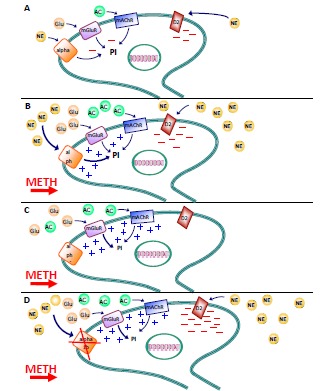Fig. (4).

Effects of NE input on activity of ventral midbrain DA neurons. The figure shows a mesencephalic DA neuron. The main receptors modulating its activity are reported. The final effect on the DA neuron is the result of the degree/type of activation of each receptor subtype depending on the levels of their endogenous ligands in the extracellular space. A) Basic conditions: NE produces a long-lasting, tonic inhibition via activation of D2 DA autoreceptors placed on neuronal dendrites. At the same time, a short-lasting inhibition of these neurons is produced by metabotropic glutamate receptors (mGluRs), muscarinic receptors (mAChRs), or alpha1 adrenoceptors. These latter three receptor subtypes produce phosphoinositide (PI) hydrolysis. B) METH administration with intact NE fibers: METH causes a robust NE release from axon terminals, and D2 and alpha1 adrenoceptors are activated by the excess of extracellular NE. Prolonged activation of alpha1 adrenoceptors depolarizes DA cells directly and indirectly via cross-desensitization of the inhibitory mGluRs and mAChRs. This occurs due to the convergence of these receptors to produce the hydrolysis of PI, which in the presence of METH is facilitated by the simultaneous release of NE, glutamate and acetylcholine. However, NE significantly reduces the stimulation of DA neurons by the concomitant activation of D2, which inhibits the firing activity of DA neurons. Therefore, the final effect on DA neurons of such NE release is inhibitory. The prevalence of D2-mediated inhibition over alpha1 adrenoceptors activation is supported by data showing that in the absence of NE, increased methamphetamine-induced DA release occurs [65, 132]. C) METH administration after NE depletion/lesion: When METH administration occurs in the absence of NE (induced either by LC fiber lesion or NE synthesis inhibition) the final effect on DA neurons is an enhanced activation, since these neurons are no longer restrained by D2 stimulation by endogenous NE. D) METH administration in the absence of alpha1 adrenoceptors activity: Alpha1 adrenoceptors antagonists (e.g. prazosin) or knocking out alpha1b adrenoceptors suppress METH-induced DA neuron activation, as testified by a reduction in DA release [129]. Along with this, METH-induced behavioural effects and DA neurotoxicity are prevented [130]. This is further confirmed by the finding that mice overexpressing alpha1b adrenoceptors are characterized by spontaneous nigrostriatal DA toxicity [131]. Alpha1, alpha1 adrenoceptor; Alpha1b, alpha1b adrenoceptors; D2, D2 dopamine receptor; mAChR, muscarinic receptor; METH, methamphetamine; mGluR, metabotropic glutamate receptor; PI, phosphoinositide pathway.
